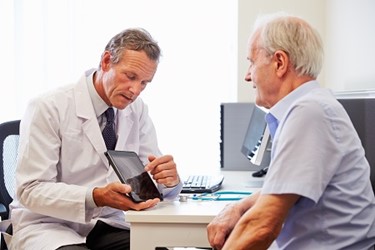Adopting eConsent To Better Patient Experience In Clinical Trials
By T.J. Sharpe, cancer blogger, survivor, and advocate

Electronic consent to clinical research — “eConsent” — is a hot topic within the clinical research world as more sponsors and sites explore what solutions are available and appropriate for them. Yet many clinical trials are stuck in paper-based consent, either underutilizing the technology tools at their disposal or not using them at all. Understanding the reasons for a transition to eConsent and the hesitancies to make these changes gives insight into one of the last bastions of the clinical research industry to embrace the digital revolution.
The Cumbersome Process Of Consent
Consent isn’t just a signature for participation in clinical research; eConsent isn’t just obtaining that signature electronically. Informed consent involves providing a potential participant with adequate information, helping them understanding this information, granting time to research and ask questions about the study, and providing follow-up information.1 If an organization simply gathers the necessary approval in an electronic format, they leave the other pillars of consent behind, potentially letting them slip through the cracks.
The consent process has its own issues, regardless of medium. The opportunity to engage and inform traditionally has been a lower priority than the letter of the FDA’s guidance and each sponsor’s interpretation of their compliance responsibilities. The process of consent is, too often, research site personnel reviewing a sponsor-supplied and institutional review board-approved consent form, with little or no supporting information. The consent document (and it is almost always a document, though it is not required to be) tends to sound like it was crafted by legal experts instead of educational ones.
This leads to a consent process where the first task is deconstructing clinical trial information terms in the most patient-unfriendly way possible. By adding a layer of legalese to medical terminology and expecting a layperson to digest this information while making an often-critical medical decision, the clinical research world has made a difficult task even more burdensome. Enhancing informed consent, along with the delivery medium, could transform a difficult checkbox into a productive, informative, shared experience.
Enter eConsent.
What Is eConsent?
eConsent is the electronic version of the traditional informed consent and its form — and has the potential to be transformative to the entire consenting process. Content delivery via multimedia is the next wave of progress in communications between the industry and volunteers who donate their time and their bodies to advance science.
The nonprofit organization TransCelerate has completed an eConsent awareness initiative, complete with guidance and tools for implementation. (Disclosure: I am a patient advisor for several TransCelerate work streams, although I did not participate in this one.) Among the adoptable solutions is an Implementation Guidance, an extremely detailed collection of background information, different components for drafting electronic informed consent, and a considerations guide for planning and executing an eConsent implementation. This guidance pulls together knowledge from multiple sources with eConsent experience — not only participating TransCelerate member companies, but patient and site advocacy groups, a CRO forum, health authorities, and ethics committees.2
A major consideration of eConsent is how technology is shaping the consumers of content — specifically, patients and their caregivers who are considering clinical research. Increasing availability of digital media has shifted processes all along the clinical trial continuum toward digital medicine — from major efforts like electronic health records, document management, and clinical data being stored and analyzed in cloud computing environments to smaller or more innovative initiatives such as electronic patient-recorded outcomes, trial adherence applications, and simple treatment reminders. All were elements of the traditional clinical trial world that have taken technology advances into the digital domain.
eConsent will replace one of the last paper-based relics of the clinical trial industry. However, the conversion process has its hiccups. What are the opportunities and obstacles to eConsent, and how are they handled?
Opportunities Of eConsent
Adopting eConsent gives a host of benefits to each stakeholder group in the clinical research world. Sponsors and consent providers can now streamline the processes around consent, including consent monitoring and re-consenting participants. There are also patient recruitment and retention implications, with eConsent tools opening opportunities to facilitate getting, and keeping, the appropriate patient population in the study.
Sites can reduce the administrative and time burdens inherent to the traditional consent process. Integrating eConsent into existing trial SOPs should increase patient education and reduce time-consuming paper processes: downloading, printing, reviewing, signing, scanning, and filing a consent or re-consent for each patient are repetitive tasks that suck time from a site’s trial team. Less time explaining means more time practicing medicine. eConsent, when fully integrated, can give sites effective tools to properly, efficiently, and openly communicate trial details during the entire informed consent process.
eConsent also presents a way to bridge trial access to many who traditionally didn’t have the opportunity or chose not to participate. While not a silver bullet to fixing underserved and underrepresented populations in clinical trials, eConsent has the ability to equip research sites with better tools to connect with potential participants in words and ways that are comfortable for those populations. It is often a struggle to engage socially disadvantaged patients in clinical research; disadvantage indicators include limited education, English proficiency, literary rates, female gender, uninsured or Medicaid status, non-U.S. nativity, and non-white or Hispanic ethnicity.3 Multimedia crosses these divides more seamlessly, with lower costs, and with greater adaptability to individual and community circumstances. Utilizing the many modalities of eConsent can deliver the appropriate message to any patient, not just those who are proficiently literate in English or Spanish.
Navigating The Obstacles To Adoption
That the consent document is used as legal cover-your-posterior more than an inform-your-participants step is the first hurdle to overcome, regardless of delivery medium. eConsent that “paves the cowpath” will simply be the same sets of difficult-to-comprehend information, just delivered in a different way. The barriers to eConsent adoption generally fall into common areas — legal and financial.
Being an innovator in the clinical research world means adopting innovation without fear of failure. Too often, sponsors approach innovation with a “second-to-market” mindset — let somebody else be the proof of concept, so any failures or pitfalls are someone else’s problem and successes allow for copycat programs that replicate another company’s achievements with significantly less risk. This mindset keeps truly innovative ideas — even ones as scrutinized as eConsent — from being universally adopted until market conditions force them to be. There may be pushback from internal legal and compliance teams, despite existing regulatory guidance and vetted industry practices.
Perhaps the least convincing argument of all is budget constraints. Yes, it costs money to implement and develop materials on an eConsent platform, more than a traditional paper-based document — particularly for first iterations. Some of this cost will be sunk into technology integration and training that any system faces, but the opportunity cost of delaying systems integration is more than just dollars; it can be that companies are left behind when a technology is demanded by the marketplace as a standard offering. The impact of enabling eConsent cannot simply be measured by a line item. Enhancing prospective participants’ understanding of a sponsor’s trial can increase trial accrual rates and decrease time to accrue, cost savings that are not readily apparent in an initial budget. Increasing patient satisfaction also has a positive impact for the sponsor, the site, and clinical research in general.
The Patient Perspective On eConsent
As a patient, I was never offered an eConsent form to sign, nor were any of the tools of eConsent utilized to help me make an informed decision on trial participation. Had they been available, there likely would have been less confusion on details and timeline for my second trial and better education and more retained knowledge on some of the more technical and scientific details on my first trial. As re-consents happened — at least a half-dozen — it certainly could have made the process leaner, faster, and generally less painful. For any patient, and particularly those with lower health literacy, transforming the jumble of words over 20+ pages into a meaningful, interactive consenting process would certainly make comprehension easier, better, or both.
From the FDA’s own website: “Informed consent means that the purpose of the research is explained to them [patients], including what their role would be and how the trial will work.”
This is the biggest miss that I have seen time and time again: informed consents contain information, but do not inform. The eConsent model has the potential to change that. Incorporating audio/visual for those who learn better or feel more comfortable receiving educational materials via that medium can help understanding and adherence. eConsent should be defined as an experience, not a compliance result — one with a goal to reach understanding and multiple modalities to achieve that goal based on individual circumstance. Flashy tools are nice, but simple, understandable information at the time of need brings the most value to patient and their caregivers. Adopting eConsent would be a major step forward if the tools available are leveraged to provide a true upgrade to the consent process and materials.
The Future Of eConsent
There is hope that the industry will recognize the benefit of universal adoption of eConsent for all stakeholders. It has the opportunity to bring operational efficiencies to the business side of clinical research while giving sponsors and sites the chance to truly inform potential participants using all available technologies that are appropriate for individual patients. It is an adoptable initiative with regulatory support and guidance and existing vendors to navigate effective compliance. There are long-term financial advantages and short-term trial participation benefits. Best of all, patients will understand what they are agreeing to, in ways that make sense to them. It will move the process of informed consent away from the focus on consent and toward the goal of truly informed clinical research participants.
References:
- https://www.fda.gov/patients/clinical-trials-what-patients-need-know/informed-consent-clinical-trials
- http://www.transceleratebiopharmainc.com/wp-content/uploads/2017/11/eConsent-Implementation-Guidance.pdf
- Enard et al. 2016. BMC Med Inform Decis Mak. doi:10.1007/s11606-016-3609-2
About The Author:
 T.J. Sharpe is a stage IV melanoma patient sharing his journey through cancer in his Patient #1 Blog. Diagnosed in 2012 with tumors in multiple organs, he has undergone six surgeries and four immunotherapies across two clinical trials. The initial failures, and subsequent response, have been chronicled in his posts. He is a keynote speaker and consultant to the biopharma and clinical research industries, working with major pharmaceutical corporations and as a patient advisor to TransCelerate to bring an educated patient voice as a true stakeholder in challenging healthcare's status quo. A South Jersey native, T.J. lives in Fort Lauderdale, FL, with his wife, Jennifer, and two young children, Josie and Tommy, and can be found on Twitter at @TeamTJSharpe.
T.J. Sharpe is a stage IV melanoma patient sharing his journey through cancer in his Patient #1 Blog. Diagnosed in 2012 with tumors in multiple organs, he has undergone six surgeries and four immunotherapies across two clinical trials. The initial failures, and subsequent response, have been chronicled in his posts. He is a keynote speaker and consultant to the biopharma and clinical research industries, working with major pharmaceutical corporations and as a patient advisor to TransCelerate to bring an educated patient voice as a true stakeholder in challenging healthcare's status quo. A South Jersey native, T.J. lives in Fort Lauderdale, FL, with his wife, Jennifer, and two young children, Josie and Tommy, and can be found on Twitter at @TeamTJSharpe.
